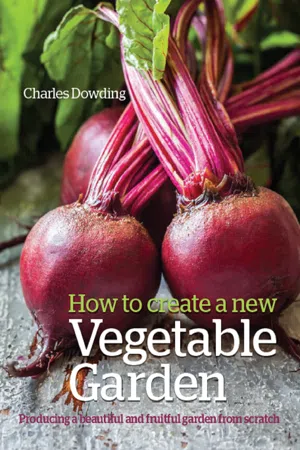CHAPTER ONE
Starting points
Formulating ideas and first steps
“Life begins the day you start a garden.”
Chinese proverb
A garden grows with you, and the way that it evolves is a big part of the pleasure. Start small, nurture ideas, and develop some plans in your mind and also on paper. The main thing is to create a garden that matches your available time, because it is far more enjoyable to be always in control of growth, weeds in particular, than to be struggling to stay on top of things. It’s important to keep an open mind about trying some different approaches as the garden grows, and I recommend that you read the first chapters of this book before becoming too involved! This chapter offers some guidance about where to start and how to manage your plans, with an example of my first project in the new garden.
How much garden you can manage depends on how you set it up, what you grow, how much time you can give and also your level of fitness. The last improves with gardening – an absorbing hobby which can draw you into doing more.
The first few months are key in clearing space: according to what you find there may be stones and rubble to clear, vigorous weeds to mulch and overgrown trees and bushes to cut back, as described in Chapters 3 and 4. This is an intensive phase of garden creation, before things settle down.
One way in which growing vegetables differs from growing ornamentals is in the extra time needed to harvest and prepare or store produce. Then after that there is ground to be cleared before starting again, often replanting the same space twice in a season. Intensively planted, smaller areas can be as productive as weedier and less well-tended larger areas. So, for a busy person, it is worth considering starting with just one bed.
Starting out at Homeacres I had occasional help from Steph and friends, and some help later with harvesting salads, but mainly the labour is my own, on a plot of three-quarters of an acre. It is not full-time, as I have other commitments. The labour-saving methods I explain in this book make it possible to garden a larger area in less time than would otherwise be possible.
To design or not
Everything is achievable, and it’s a big help to mull things over while your feet are, literally, on the ground: imagine some ideas while out there, not just by looking at a plan on paper. Even if you have little experience, nothing beats making pictures in the head, while in the garden. Put an imaginary greenhouse right there and then see with your mindʼs eye if it would be easy to access, how it would look and how it might relate to the rest of your garden. Nurture the ideas you have and sketch them out as a temporary framework or guideline, just in a rough way. Then be prepared as things manifest to alter any bit that feels wrong or impractical. You will find that new and exciting ideas can pop up while actually gardening, which is a highly creative process.
I found that Homeacres daunted me with its overgrown aspect – there seemed too much that I needed to do. Ideas for a new garden were bubbling in the background, but they felt nebulous and uncertain at that stage.
Somehow I needed to have a garden running by next spring, as a base for courses, writing and visits by groups keen to learn. What might I show them?
As it turned out, the answer was “A lot”, for example the many possible ways to clear ground, clean soil, create a growing space and have harvests in a short time period. If you like working to a plan, I suggest having one with a ‘t’ on the end – a growing plan that can change and adapt to weather, weeds and growth as it happens.
Time, energy, health
A bold and beautiful plan is useless unless you can give it the necessary time and energy, or have the money to make time. You also need a commitment to turn your wishes into reality, so it is good to ask yourself “How much do I really want that?” A powerful “Very much” will help you somehow make it happen.
Gardening is a physical activity, and the more you do, the more your muscles respond with new energy after an initial tiredness. At first, doing a little regularly is important: keep going and then feel rewarded as your body strengthens, warms up and looks better too. Gardening improves your mental health too, especially in terms of the uplifting effects of working physically outdoors, even in poor weather. Being outside in winter is a powerful tonic, allowing more light to your body at a time when it is particularly valuable for feeling in good spirit. Then you gain more health by eating the vibrant food you have grown. Thanks to all these factors I enjoyed good health while I was creating my garden at Homeacres and never missed a day, or even an hour, to ill health, throughout a wet winter and bitterly cold spring, all du...








